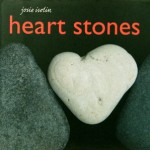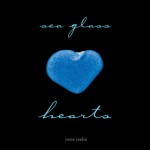Dear Reader: Heart Stones is my most favorite Valentine’s Day book, ever. I own and have given several of Josie’s books for presents. MitM is honored to feature her, for Valentine’s Day.
Q: Josie, your first book is called Loving Blind/Seeing Red: A Mother’s Decade. It features a series of images with connecting anecdotes about life with small kids which was inspired by your earliest path through motherhood. As the mother of three children, now ranging in age from 15 to 20, they appear to be your driving force, motivation and inspiration. Please tell me more about your journey with them and how it has contributed to your finding your life’s work.
I had my first baby (20 years ago nearly today in fact!) at midwinter break in the second of three years of an MFA program and when done, I thought I would be teaching pretty consistently. But teaching in the arts is initially a transient thing…The reality was that the best economic model for our family was for me to be home with the kids…and it was a gift to us as a family and to me as an artist. My studio is just downstairs (through the backyard) from the kitchen and my work and life are intertwined, physically as well as psychically. My kids and my husband always inspire me to do better work.
Q: Tell me about your experience of “motherhood,” as it relates to your own upbringing.
When I was about six, my mother went to law school and then became a hard-charging lawyer in New York in the seventies and eighties. She was an amazing mom but throughout my years of college and beyond, it was assumed that one would be working incredibly hard at some spectacular job and family would just fit in. When I wasn’t working at some spectacular job, or any job for that matter, it didn’t seem to be understood very well. In fact it seemed like forging a whole new frontier. Heavens, sending my kids to public school was a first for my family. But it did feel like falling off the grid (not working at a paying job) and it has been a constant struggle to climb back onto it.
Q: Your college degrees in visual and environmental studies, and in fine arts, are an interesting combination. I assume these helped you create the technique called Scannography? I’m interested in learning more about this method.
I started using the scanner as a way to keep making imagery when the kids were small. It is a very efficient way to work as a photographer and a designer. I got hooked on the technique in 1994 when I scanned some dryer lint that had been accumulating next to the dryer: big circles of beautifully colored lint peeled off of the circular lint trap at the back of the second-hand dryer. I then started scanning everything around the house which led to both the Loving Blind book and then Beach Stones (yes I have a lot of stones lying around the house). I have been using the scanner exclusively ever since.
The pairing of word and image – i.e. the task of the visually driven book maker—has become the conceptual cornerstone to my work. It started when I paired the very universal images with the very personal anecdotes and designed and redesigned Loving Blind/Seeing Red, acknowledging that the extremes of emotion and push and pull of being a mother was fertile ground for creative work…was creative work itself.
At Harvard, the undergraduate department of Visual and Environmental Studies is the studio art department. I took some design studios but mostly I was in the darkroom and taking photography classes; I have been making art since the beginning. There were very few science requirements at that time, and I don’t think the label environmental science even existed. So, I find myself challenged and excited to be learning the science behind the imagery as I go along. Right now, I am deep into the writing of my forthcoming book on marine algae (seaweed!) and I am diligently learning the biology of the intertidal zone. As a writer, this lack of formal training helps me to write for the non-scientist.
The MFA program (I studied) at San Francisco State, in the early nineties, was very imaginative regarding use of the computer. And the evolution to working digitally was relatively seamless. I started the program with the darkroom as my main engine, and ended the program with the computer as my tool for making. (two pregnancies with no darkroom use allowed forced the issue as well). The scanner came along as a useful tool that fit my inclinations as an artist and author and book designer, just as an artist might use an etching press or a certain camera or kind of paint.
Q: While it would appear that you are involved in the melding of both art and science, the truth is that the objects you use also have spiritual overtones – many of them have been loaned by friends as objects imbued with intimate connections; many objects you find seem to “call” you. Is spirituality at the root of all your work?
Yes, I am making portraits of these objects. They get to reveal themselves in all their glory, and my job is to let them speak. I often feel like a conservator cleaning an old, grimy oil painting and letting its true light shine through. I am not religious, but I am spiritual. The natural world has so much to teach us. Each image or object leads to questions about how it is made, its place in our cosmos, and this leads to the science and the poetry.
Q: With the exception of your first book, your subsequent books involve objects from nature. Can you speak to this connection?
I feel very connected to the natural world. I spent lots of time on the beach with my kids—it is free (this is Northern California, after all) close by; infinitely entertaining and an easy place to be with little ones. I still walk the beach twice a week. My first book proposal was Beach Stones followed immediately by Leaves & Pods and Seashells. They seemed to sell, so I made Heart Stones because I encountered so may people like myself who had a stash of them around their house. The beach as a place of wonder is never-ending for me and I seem to have a tiny niche in this area for books. Beach: A Book of Treasure is the foundational book in this regard, both a culmination and a beginning—of more complex imagery and the combining of different kinds of writing. The seaweed material I am working with now is unbelievable. As an artist and a writer, it is pretty consuming.
Q: Now that you are 50 years old and your children are leaving the nest, have you started “reinventing” yourself?
This fall has been very odd and a real turning point for our household: with two kids off to college in as many years it suddenly got very quiet and much less chaotic (I love that chaos, rest assured). I am always reinventing myself as an artist and author and small business proprietor…and now as a parent. Instead of the hectic day to day work, it is the nuance, parsing, cajoling, listening that goes on, guiding through a college experience that we can afford and is meaningful.
How does one transition from having bodies and talk and banter around, constant sports and school events to a quieter household? Writing poetry has been a part of this. (I just wrote one about watching my middle daughter be with the 17 year old boy that has won her heart–)…all inspired by feeling so intensely.
Q: What do you want your readers to take away from your work?
A renewed passion for the world around them. A sense of responsibility for it.
Q: After your seventh book publishes, in 2014, how do you envision that you will spend the rest of your life?
An important part of my job as parent is making sure every bit of scholarship money that’s out there gets found and used, and making sure the kids know that finances are a major player in where they go to college. This takes constant and concerted conversations, imagination and savvy and has been profoundly important to the economy of our household—in fact I would probably do better as a consultant in this realm. (However) I would love to eventually be able to expand the studio and take on more varied art and design projects.
Q: I, like you, am always driven by my heart. With that in mind, what one message would you like to leave with our midlife mothers this Valentine’s Day?
Live passionately—live passionately with your kids—and write stuff down!
Josie Iselin, 50, is the photographer, author and designer of seven books, with new projects in development in her San Francisco studio, Loving Blind Productions. Josie holds a BA in Visual and Environmental Studies from Harvard and an MFA from San Francisco State University.
For almost twenty years, Josie has used her flatbed scanner and computer exclusively for generating imagery. She is still captivated by the fluidity with which this technique allows her to render and design with three-dimensional objects. Josie is the mother of three children ranging in age from 15 – 20. She can be found @ http://www.josieiselin.com.


